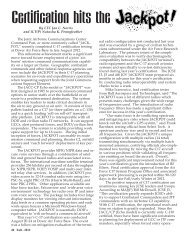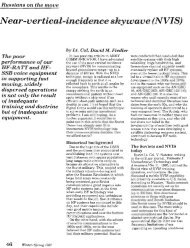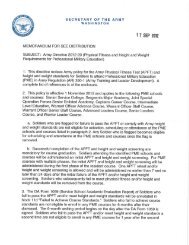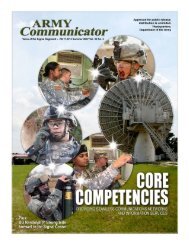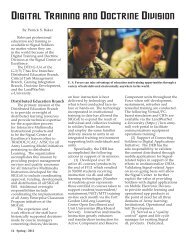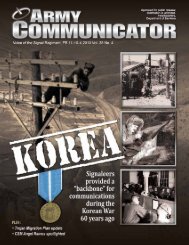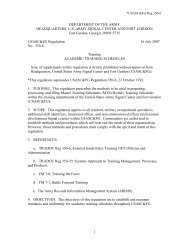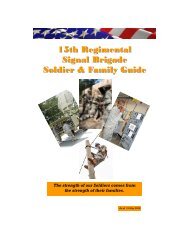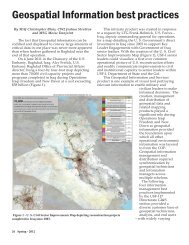AC Summer 08 WIN-T Online - United States Army Signal Center of ...
AC Summer 08 WIN-T Online - United States Army Signal Center of ...
AC Summer 08 WIN-T Online - United States Army Signal Center of ...
Create successful ePaper yourself
Turn your PDF publications into a flip-book with our unique Google optimized e-Paper software.
These test events will be used<br />
to provide data to support a<br />
System Evaluation Report for<br />
the <strong>WIN</strong>-T full rate production<br />
decision and subsequent<br />
fielding <strong>of</strong> the system.<br />
Summary:<br />
The <strong>WIN</strong>-T Increment 2 program<br />
implements a robust test<br />
strategy to provide critical information<br />
in support <strong>of</strong> key program<br />
milestones. It uses a series <strong>of</strong> “build-a<br />
little, test-a little” events <strong>of</strong> increasing<br />
complexity and scope to identify<br />
potential design problems early on<br />
and mitigate program risks.<br />
Mr. Hutchinson is the lead test<br />
engineer for the Warfighter Information<br />
Network-Tactical Increment 2 and 3<br />
program within Project Manager, <strong>WIN</strong>-<br />
T, Fort Monmouth, N.J. He has more<br />
than 30 years experience in testing<br />
complex communications and command<br />
and control systems.<br />
In his current position, he develops<br />
testing strategies and serves as the<br />
principle point-<strong>of</strong>-contact for test related<br />
issues.<br />
<strong>AC</strong>RONYM QUICKSCAN<br />
CERDEC – Communications-<br />
Electronics Research, Development<br />
and Engineering <strong>Center</strong><br />
COIC – Critical Operational Issues<br />
and Criteria<br />
HNR – Highband Network Radio<br />
IA – Information Assurance<br />
IOT – Initial Operational Test<br />
KPP – Key Performance Parameters<br />
LRIP – Low Rate Initial Production<br />
LUT – Limited User Test<br />
M&S – Modeling and Simulation<br />
MANPRINT – Manpower and<br />
Personnel Integration<br />
NCW – Net Centric Waveform<br />
NETOPS – Network Operations<br />
OTM – On-the-Move<br />
PM – Project Manager<br />
PQT – Production Qualification<br />
Test<br />
S&TCD – Space and Terrestrial<br />
Communications Directorate<br />
SDD – System Design and<br />
Development<br />
TCM – TRADOC Capabilities<br />
Manager<br />
<strong>WIN</strong>-T – Warfighter Information<br />
Network-Tactical<br />
50 <strong>Summer</strong> 20<strong>08</strong><br />
<strong>Army</strong> ready with<br />
next generation <strong>of</strong><br />
network operations<br />
By Greg Wagner<br />
The <strong>Army</strong> will be testing and<br />
fielding various increments <strong>of</strong> their<br />
flagship <strong>WIN</strong>-T program over the<br />
next 12-to-24 months; for <strong>WIN</strong>-T<br />
Increments 2 and beyond, this<br />
includes an integrated Network<br />
Operations capability. This capability<br />
represents the next generation in<br />
NetOps and, perhaps more significantly,<br />
a fundamental paradigm<br />
shift in how NetOps is accomplished<br />
tactically. This paradigm shift is<br />
largely driven by how the requirements<br />
for the <strong>WIN</strong>-T Increment 2<br />
and beyond network were written.<br />
Rather than write specific<br />
operational requirements against<br />
classic network components (e.g.,<br />
transmission, switching, network<br />
management), the TRADOC Capabilities<br />
Manager Network & Services<br />
wrote a series <strong>of</strong> network-level,<br />
performance-based requirements.<br />
This “requirements” paradigm shift<br />
resulted in an operational description<br />
<strong>of</strong> how the whole network must<br />
perform, and what the whole<br />
network must do, rather than a<br />
recitation <strong>of</strong> operational requirements<br />
against specific, isolated<br />
subsystems.<br />
These performance-based<br />
requirements are contained in the<br />
<strong>WIN</strong>-T Capabilities Description<br />
Document and the related <strong>WIN</strong>-T<br />
Increment 2 Capabilities Production<br />
Document. The CDD and CPD also<br />
include five Key Performance<br />
Parameters, which describe “musthave”<br />
capabilities, without which<br />
the system would not meet mission<br />
critical functions. One <strong>of</strong> these KPPs<br />
directly relates to NetOps (network<br />
management in particular), and two<br />
other KPPs indirectly involve<br />
NetOps.<br />
The specification <strong>of</strong> holistic,<br />
performance-based network requirements,<br />
coupled with three <strong>of</strong> the five<br />
KPPs involving NetOps directly or<br />
indirectly, requires a NetOps<br />
materiel solution that is integrated.<br />
<strong>WIN</strong>-T Increment 2 is fielding such a<br />
NetOps solution. The term “integrated”<br />
can mean many things; in<br />
the context <strong>of</strong> <strong>WIN</strong>-T Increment 2,<br />
integrated NetOps means integrated<br />
with respect to the overall network,<br />
and integrated with respect to work<br />
flow.<br />
<strong>WIN</strong>-T Increment 2 NetOps is<br />
integrated with the larger network in<br />
the sense that all aspects <strong>of</strong> the<br />
NetOps agents and technologies are<br />
located throughout the network and<br />
interact with other network components<br />
to make the automated, nearreal-time<br />
monitoring and response<br />
decisions required to meet the<br />
network-level performance metrics<br />
set forth in the CDD and CPD.<br />
These decisions must be made in<br />
concert with decisions made in other<br />
network subsystems such as routing<br />
and switching, admission control,<br />
and transmission to yield a predictable<br />
and guaranteed speed <strong>of</strong> service<br />
for different types <strong>of</strong> traffic (voice,<br />
video, data) and different traffic<br />
importance (critical, routine, etc.) so<br />
as to meet the commander’s priorities<br />
for information flow. These<br />
sorts <strong>of</strong> decisions cannot be made by<br />
stand alone packages residing in a<br />
central location.<br />
<strong>WIN</strong>-T NetOps is integrated<br />
with respect to work flow in the<br />
sense that all aspects <strong>of</strong> the NetOps<br />
process, from planning through<br />
administration to monitoring and<br />
response, are accomplished by a<br />
single framework containing all<br />
requisite data and functions, and



